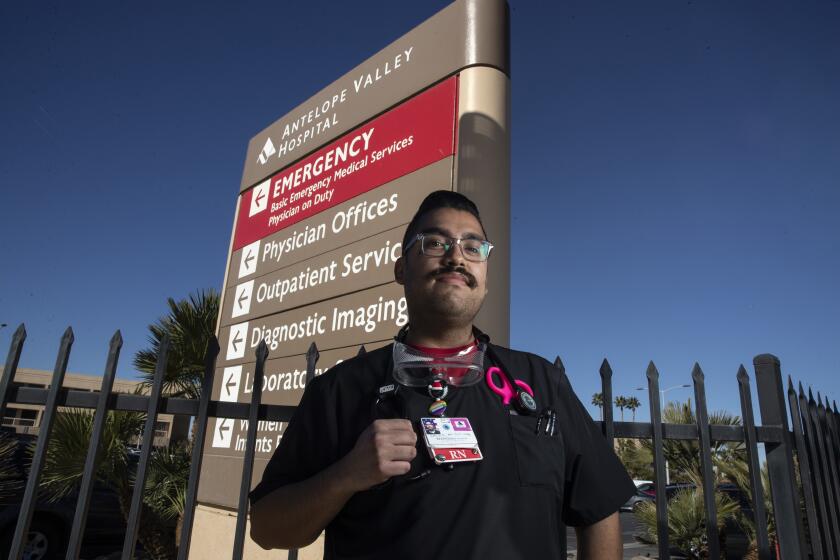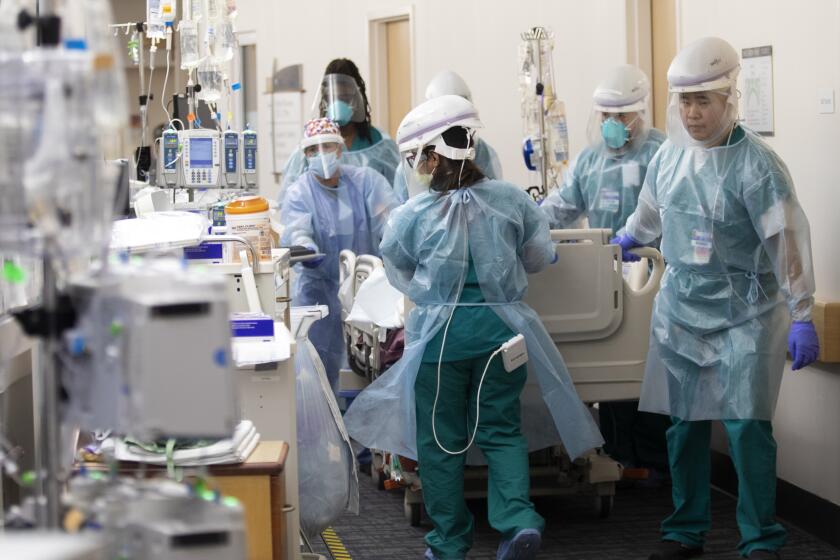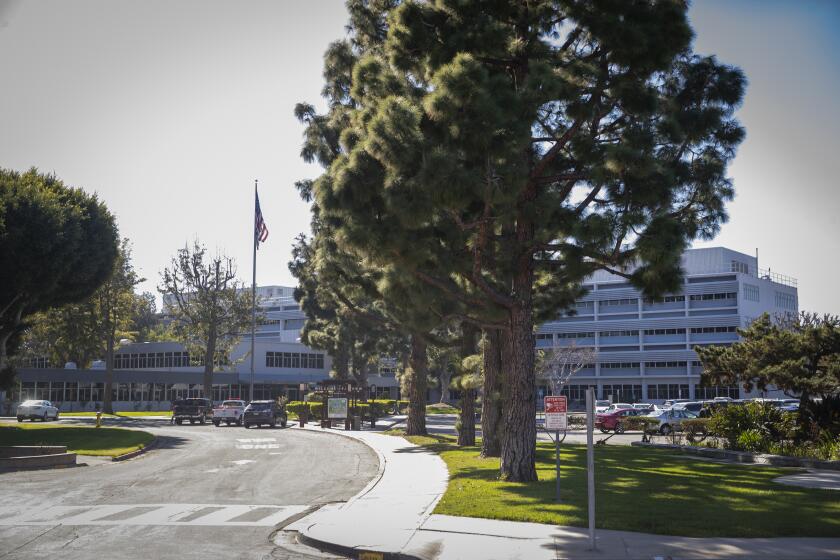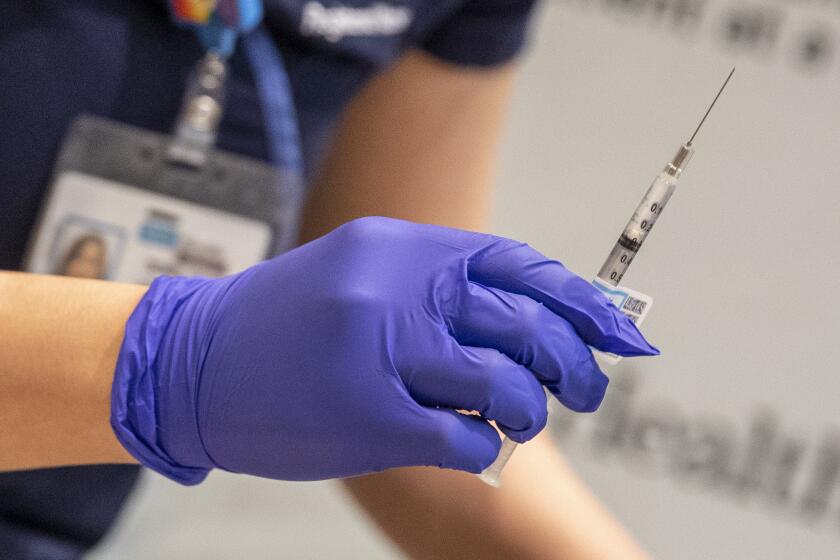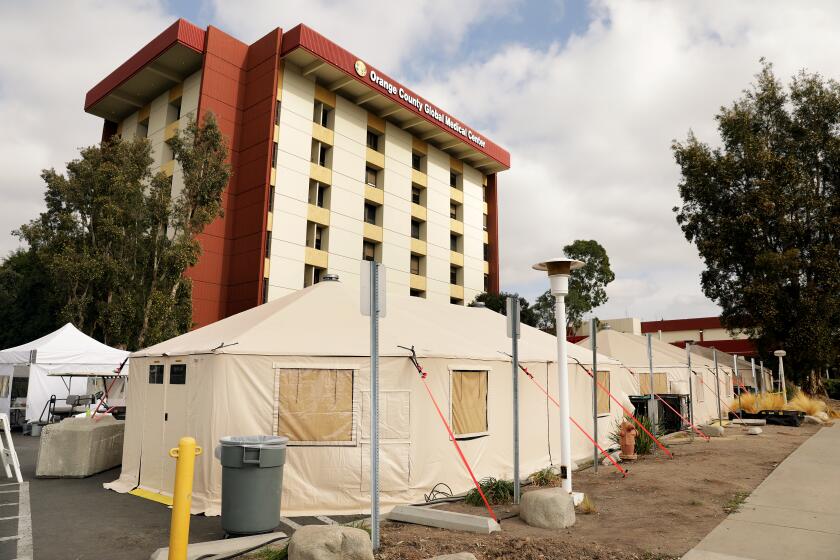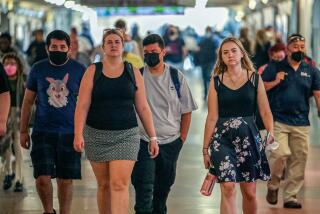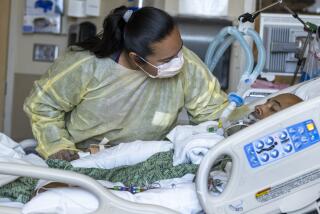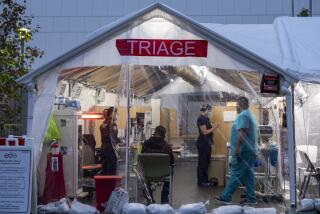L.A. County hospitals ‘under siege’ from COVID-19 as deaths, cases hit new daily highs

A ferocious COVID-19 surge is besieging Los Angeles County’s hospitals like never before, officials said Wednesday, as the region reported an all-time daily high of 134 deaths from the disease and a record number of new infections.
Single-day records were shattered across California Wednesday. A Times county-by-county tally found 51,724 new coronavirus cases reported, shattering the state’s single-day record broken on Monday, when 42,088 cases were reported.
The Times tally also found 393 COVID-19 deaths Wednesday across the state, breaking the record set Tuesday, when 295 deaths were recorded. Cumulatively, California has now reported 1.7 million coronavirus cases and 21,887 COVID-19 deaths.
California is now tallying an average of 203 COVID-19 deaths a day over a weekly period, and 35,200 cases a day — both records, and both quadruple the numbers from mid-November.
A great deal of the state’s surge has been fueled by L.A. County, where the unrelenting rise in the number of coronavirus-infected Angelenos falling ill enough to require professional care is straining the county’s medical system, raising renewed fears that the need for beds could outstrip those available despite healthcare workers’ herculean efforts to expand capacity.
Dr. Christina Ghaly, the county’s director of health services, put it bluntly Wednesday: “Our hospitals are under siege, and our model shows no end in sight.”
More harrowing still, she said, is that “the worst is still before us.”
To the outside world, COVID-19 statistics may be little more than numbers, but in Southern California’s hospitals, conditions are rapidly deteriorating.
As officials have long noted, hospitalizations are a lagging indicator of the coronavirus’ spread, typically reflecting exposures that took place two to three weeks prior.
Increases in coronavirus case counts, then, will typically lead to an uptick in the number of hospitalized patients a few weeks down the line.
And infections have never been higher in L.A. County. There were 22,469 new coronavirus cases reported Wednesday, according to an independent Times tally.
Though that figure was inflated by a backlog of about 7,000 test results that were reported late, “these are nonetheless extraordinary numbers, and they represent transmission that continues to be out of control,” said county Public Health Director Barbara Ferrer.
The previous record for the highest number of cases in a single day in L.A. County was 13,507, set Friday. The old high-water mark for deaths was 93, set Tuesday, according to an independent Times tally.
“Every hour, on average, two of our neighbors, family members and friends are dying from COVID-19, and the virus is rampant in all neighborhoods,” Ferrer said during a briefing Wednesday. “We have the most difficult road yet in front of us, and I encourage everyone to stay home as much as possible, protect your families and friends, and take every precaution that’s available to you.”
“Unless we remain more vigilant and more diligent through the holidays and beyond, we will not be able to stop the surge and provide essential relief to our hospitals and our healthcare workers.”
Tuesday’s statewide COVID-19 death toll was 35% higher than the record tally set only a week ago.
The number of new cases is particularly distressing as L.A. County’s hospitals are already contending with an unprecedented crush of patients. The number of coronavirus-positive patients in hospitals countywide Tuesday, 4,864, is a record, and six times higher than the number on Nov. 1.
Of particular concern are the county’s intensive care units, which are needed for the patients in worst condition — be they suffering from COVID-19, a severe injury or other crises such as a heart attack or stroke.
There, too, the county has seen a sharp increase. Tuesday’s number of coronavirus-positive ICU patients, 991, is five times worse than in mid-October.
Healthcare officials have some options to preserve ICU capacity, such as canceling scheduled surgeries, keeping critically ill patients in emergency rooms, sending ICU patients into step-down units earlier, training nurses from other units to help with intensive care, and increasing the number of patients each ICU nurse cares for.
But officials emphasize that those steps are neither sustainable for the long term nor sufficient if the patient load continues to rise.
The eventual consequence, Ghaly said, will be “a hospital system and an emergency medical services system that cannot provide the level of care that we all expect or would want for ourselves or our loved ones.”
“Hospitals are working feverishly to staff up additional ICU beds, but there are simply not enough trained staff to care for the volume of patients that are projected to come and need care,” she said.
State officials have previously estimated that 12% of newly diagnosed coronavirus cases are likely to require hospitalization, with 12% of those that have been hospitalized eventually ending up in the ICU.
At this point, Ghaly said, “all our hospital systems can do is brace for these days and weeks to come.”
The field hospitals will care for non-ICU patients in places including Costa Mesa, Porterville, Sacramento and Imperial. More are on standby.
The dire situation in California’s most-populous county is indicative of the deteriorating situation statewide.
ICUs have rapidly filled up throughout the state as infections have soared.
In Southern California — a sprawling region the state defines as Imperial, Inyo, Los Angeles, Mono, Orange, Riverside, San Bernardino, San Diego, San Luis Obispo, Santa Barbara and Ventura counties — only 0.5% of available ICU beds remained unfilled Wednesday, state figures show.
The situation was bleaker still in the San Joaquin Valley, where ICU availability again tumbled to zero.
In the Bay Area, ICU availability slid Wednesday to 12.9% — below the 15% threshold the state has set for imposing sweeping new restrictions on businesses and activities aimed at curtailing the coronavirus.
Many of the region’s counties took it upon themselves to implement the new rules. Those that didn’t — San Mateo, Solano, Santa Cruz and Napa counties — will see a regional stay-at-home order, which reduces capacity at retail stores; closes businesses including hair salons, nail salons, card rooms, museums, zoos and aquariums; and prohibits most gatherings, hotel stays for tourism and outdoor restaurant dining — go into effect at 11:59 p.m. Thursday.
Such orders are already in place across Southern California, the San Joaquin Valley and Greater Sacramento. Only rural Northern California has escaped the additional restrictions so far.
The new orders mean 98% of California’s residents, or 38 million people, are under regional stay-at-home instructions, affecting 47 of 58 counties.
The increase in deaths has been so severe that state officials have had to order 5,000 body bags and 60 refrigerated storage units, each 53 feet long, for storing corpses, Gov. Gavin Newsom said Tuesday. Newsom also said he has activated the state’s mutual aid and mass fatality program for coroners.
COVID-19 hospitalizations have never been higher: As of Tuesday, there were 14,939 hospitalized COVID-19 patients statewide, including 3,188 in intensive care. The record for COVID-19 hospitalizations has been broken for 18 consecutive days, and the number has more than doubled since Thanksgiving.
Though the state has recently begun receiving shipments of COVID-19 vaccine, officials emphasize that those shots will do little, if anything, to slow down the current surge.
“Let’s deal with some sober realities,” Newsom said. “This is a deadly disease. And we need to be mindful of where we are in this current journey together to the vaccine: We are not at the finish line yet.”
Los Angeles city officials worry that residents could be the next target of fraudsters peddling the promise of a dose of COVID-19 vaccine.
Officials said the soaring numbers in recent weeks point to a sobering reality: That despite all the warnings, not enough people took seriously the call to avoid holding parties and events for the Thanksgiving holiday.
“We are seeing the impact of what happened over Thanksgiving,” Ghaly said. “It does not seem that enough people heard and followed the message to stay home and avoid gathering with others.”
That’s especially concerning given that the wider winter holiday season is in full swing.
“I am afraid,” Dr. Clayton Chau, Orange County’s health officer and Health Care Agency director, said Tuesday. “I have never been so afraid of Christmas and New Year’s in my life like I have now, because ... I can’t imagine what it would be like after the holiday if people are not listening, if people are not complying, if people are in defiance and get together.”
As COVID-19 cases soar, Orange County will deploy mobile field hospitals to relieve some of the stress on the region’s healthcare system.
The figures announced Wednesday should be persuasive enough to “cancel holiday plans that involve travel or gathering with friends and family that are not part of your household,” Ferrer said.
“The catastrophic impact of this continued high rate of transmission is really devastating for our hospitals and for people’s lives,” she said.
The sad but simple reality, officials and experts say, is that the coronavirus is now so widespread in California that activities believed to be relatively safe just months ago now present greater risk than they ever have.
This, Ghaly said, means that “having just a very small birthday party for your child in a park is not safe. Having a very small holiday gathering is not safe. Getting together with a couple of friends at dinner is not safe. Participating in a sports tournament, whether it’s formal or informal, is not safe.”
“If you don’t do everything possible to minimize spread, then you are contributing to the spread and prolonging the amount of time in which our hospitals have more patients ... than they can safely handle,” she said.
Times staff writer Sean Greene contributed to this report.
More to Read
Start your day right
Sign up for Essential California for news, features and recommendations from the L.A. Times and beyond in your inbox six days a week.
You may occasionally receive promotional content from the Los Angeles Times.
